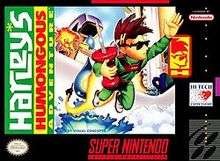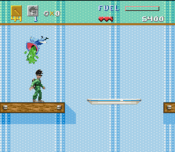Harley's Humongous Adventure
| Harley's Humongous Adventure | |
|---|---|
 North American box art | |
| Developer(s) | Visual Concepts |
| Publisher(s) | |
| Composer(s) | Brian Schmidt |
| Platform(s) | Super NES |
| Release date(s) |
|
| Genre(s) | Action |
| Mode(s) | Single-player |
Harley's Humongous Adventure, known in Japan as Kagakusha Harley no Haran Banjou (化学者ハリーの波乱万丈, "Chemist Harley's Stormy Life"), is a side-scrolling platform video game released in 1993 for the Super Nintendo Entertainment System.
Summary
It was originally developed by Visual Concepts, and funded by publisher Electronic Arts, but eventually published by Hi Tech Expressions.
The player controls Harley, a man in a green suit who has shrunk himself to size of a bar of soap. The player's mission is to gather parts of Harley's (presumably) now-destroyed shrinking machine to return him to normal size. As the player advances through levels, they pick items such as tacks, rubberbands and marbles. The many locations the player adventures through is Harley's lab where the initial incident occurs, Harley's Kitchen, Harley's toy room, where the player pilots a toy tank by himself, Harley's Bathroom, and other stages. The Box Art (at right) was created for EA by veteran gaming illustrator Marc Ericksen and features Harley blasting out of the kitchen sink, holding a red plastic push pin for scale reference.

This is an old school 2D platform game. Enemies include flies, bees, ants and the main boss is a deformed rat that tries to jump on the player, and after each encounter utilizes a household item for the limb he lost in the last encounter.
Visually, the game utilizes a mix of pixel art for the stage backgrounds, the menus and most objects, and digitized clay animation models for all characters. The clay animation was produced by A-OK Animation, who had also worked on Claymates, another Super NES game featuring a somewhat similar graphical style.
The game was programmed, and designed in part, by Brian Greenstone of Pangea Software. This programmer previously wrote games for the Apple IIGS computer, which happens to share the same 65C816 microprocessor as the Super NES.
Reception
On release, Famicom Tsūshin scored the game a 21 out of 40.[1]